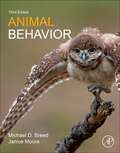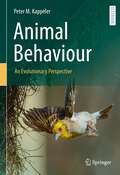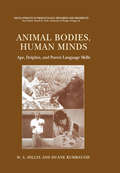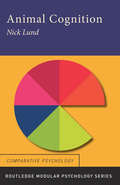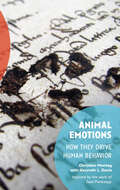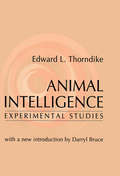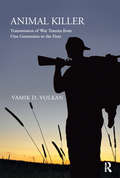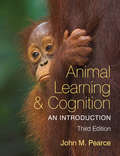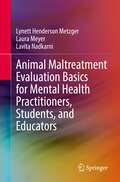- Table View
- List View
Animal-Assisted Therapy with Dogs: Basics, Animal Ethics and Practice of Therapeutic Work
by Katharina BleschAnimal-assisted therapy has been the talk of the town for several years and is increasingly being integrated into the psychotherapeutic treatment of people. But how exactly can dogs support psychotherapeutic work? How can animal welfare and human welfare be combined? Which dogs are suitable and how are they prepared? This book provides a practical and lively insight into therapeutic work with dogs. In addition to an overview of the basics as well as animal welfare and ethical aspects of dog-assisted therapy, concrete exercises in the context of dog-assisted self-confidence training are described pictorially and by video, providing inspiration for therapeutic work in various institutions and situations.
Animal Behavior (PDF)
by Michael D. Breed Janice MooreAnimal Behavior, Third Edition covers animal behavior from its neurological underpinnings to the importance of behavior in conservation. The book's authors, Michael Breed and Janice Moore, bring almost 60 years of combined experience as university professors, much of that teaching animal behavior. Chapters cover this social behavior and the relationship between parasites, pathogens and behavior. Thoughtful coverage has also been given to foraging behavior, mating and parenting behavior, anti-predator behavior, and learning. The book addresses the physiological foundations of behavior in a way that is both accessible and inviting, with each chapter beginning with learning objectives and ending with thought-provoking questions. Additionally, special terms and definitions are highlighted throughout, making this book an essential work for students and academic seeking a foundation in the field.
Animal Behaviour: An Evolutionary Perspective
by Peter M. KappelerThis textbook presents all basic principles of animal behaviour in a clear and concise manner and illustrates them with up-to-date examples. Emphasis is placed on behavioural biology as an integrative discipline of organismic biology, focusing on the adaptive value of behaviours that facilitate resource access, predator avoidance and reproductive success and underlie parental care, all within a comprehensive presentation of social complexity. This new textbook provides a rich resource for students (and teachers) from a wide range of life science disciplines.
Animal Bodies, Human Minds: Ape, Dolphin, and Parrot Language Skills (Developments in Primatology: Progress and Prospects)
by W.A. Hillix Duane RumbaughSeveral books chronicle attempts, most of them during the last 40 years, to teach animals to communicate with people in a human-designed language. These books have typically treated only one or two species, or even one or a few research projects. We have provided a more encompassing view of this field. We also want to reinforce what other authors, for example Jane Goodall, Sue Savage-Rumbaugh, Penny Patterson, Birute Galdikas, and Roger and Deborah Fouts, so passionately convey about our responsibility for our closest animal kin. This book surveys what was known, or believed about animal language throughout history and prehistory, and summarizes current knowledge and the controversy around it. The authors identify and attempt to settle most of the problems in interpreting the animal behaviours that have been observed in studies of animal language ability.
Animal Cognition (Comparative Cognition and Neuroscience Series)
by H. L. Roitblat, T. G. Bever and H. S. TerraceFirst published in 1984. Routledge is an imprint of Taylor & Francis, an informa company.
Animal Cognition (Routledge Modular Psychology)
by Nick LundAnimal Cognition looks at how non-human animals process information from their environment. Nick Lund has written an accessible and engaging account of this area of comparative psychology. The book contains chapters on animal navigation (including homing behaviour and migration), animal communication methods and research into animal language, and attempts to teach language to non-human animals. A chapter on memory includes models of memory in non-human animals and discusses the importance of memory in navigation and foraging behaviour.Animal Cognition is designed to cover the AQA(A) A2 level specification but will also be of interest to undergraduates new to comparative psychology. It is well illustrated and includes a study aids section with examination questions and answers, and key research summaries.
Animal Cognition (Routledge Modular Psychology)
by Nick LundAnimal Cognition looks at how non-human animals process information from their environment. Nick Lund has written an accessible and engaging account of this area of comparative psychology. The book contains chapters on animal navigation (including homing behaviour and migration), animal communication methods and research into animal language, and attempts to teach language to non-human animals. A chapter on memory includes models of memory in non-human animals and discusses the importance of memory in navigation and foraging behaviour.Animal Cognition is designed to cover the AQA(A) A2 level specification but will also be of interest to undergraduates new to comparative psychology. It is well illustrated and includes a study aids section with examination questions and answers, and key research summaries.
Animal Cognition (Comparative Cognition and Neuroscience Series)
by H. L. Roitblat H. S. Terrace T. G. BeverFirst published in 1984. Routledge is an imprint of Taylor & Francis, an informa company.
Animal Cognition: Evolution, Behavior and Cognition
by Clive D. Wynne Monique A. UdellThoroughly updated for its third edition with the latest research in the field, this innovative text delivers an apt and comprehensive introduction to the rich and complex world of animal behaviour and cognition. Discover pivotal case studies and experiments that have irrevocably shaped how we view the psychological and social lives of animals and discover such key cognitive topics as memory, communication and sensory perception. Projecting an insightful scope into the cognitive world of animals, from considering the use of tools in birds to the dance communication system of the honey bee, Wynne and Udell analyse and explain the importance of the observations and studies that have led to the greater understanding of how animals learn, perceive social relations, form concepts, experience time and navigate space. Written by two leading researchers in the field, including the author of the best-selling popular science book Dog is Love, this textbook is a complete resource for students of animal cognition, animal behaviour or comparative psychology.
Animal Cognition: Evolution, Behavior and Cognition
by Clive D.L. Wynne Monique A. UdellWhat occupies the mind of an animal? To what extent do they experience consciousness? Is there such a thing as culture in the animal kingdom? For those new to this fascinating topic, this innovative text delivers an apt and comprehensive introduction to the rich and complex world of animal behaviour and cognition. Discover pivotal case studies and experiments that have irrevocably shaped how we view the psychological and social lives of animals and discover such key cognitive topics as memory, communication and sensory perception. Projecting an insightful scope into the cognitive world of animals, from considering the use of tools in birds to the dance communication system of the honey bee, Wynne and Udell analyse and explain the importance of the observations and studies that have led to the greater understanding of how animals learn, perceive social relations, form concepts, experience time and navigate space. Written with the student-reader in mind, this text provides the ideal introduction to this excitingly progressive field in psychology to any undergraduate undertaking courses in animal behaviour and comparative psychology. This book is for those who desire to learn an up-to-date history of cornerstone theories in the field thus far and gain a comprehensive introductory understanding into the function and evolution of the broad range of cognitive and behavioural faculties in animals.
Animal Cognition: Evolution, Behavior and Cognition
by Clive D.L. Wynne Monique A. UdellThoroughly updated for its third edition with the latest research in the field, this innovative text delivers an apt and comprehensive introduction to the rich and complex world of animal behaviour and cognition. Discover pivotal case studies and experiments that have irrevocably shaped how we view the psychological and social lives of animals and discover such key cognitive topics as memory, communication and sensory perception. Projecting an insightful scope into the cognitive world of animals, from considering the use of tools in birds to the dance communication system of the honey bee, Wynne and Udell analyse and explain the importance of the observations and studies that have led to the greater understanding of how animals learn, perceive social relations, form concepts, experience time and navigate space.Written by two leading researchers in the field, including the author of the best-selling popular science book Dog is Love, this textbook is a complete resource for students of animal cognition, animal behaviour or comparative psychology.
Animal Cognition: A Tribute To Donald A. Riley (Comparative Cognition and Neuroscience Series)
by Thomas R. ZentallPrepared as a tribute to Donald A. Riley, the essays that appear here are representative of a research area that has loosely been classified as animal cognition -- a categorization that reflects a functionalist philosophy that was prevalent in Riley's laboratory and that many of his students absorbed. According to this philosophy, it is acceptable to hypothesize that an animal might engage in complex processing of information, as long as one can operationalize evidence for such a process and the hypothesis can be presented in the context of testable predictions that can differentiate it from other mechanisms. The contributions to this volume represent the three most important areas of research in animal cognition -- stimulus representation, memory processes, and perceptual processes -- although current research has considerably blurred these distinctions.
Animal Cognition: A Tribute To Donald A. Riley (Comparative Cognition and Neuroscience Series)
by Thomas R. ZentallPrepared as a tribute to Donald A. Riley, the essays that appear here are representative of a research area that has loosely been classified as animal cognition -- a categorization that reflects a functionalist philosophy that was prevalent in Riley's laboratory and that many of his students absorbed. According to this philosophy, it is acceptable to hypothesize that an animal might engage in complex processing of information, as long as one can operationalize evidence for such a process and the hypothesis can be presented in the context of testable predictions that can differentiate it from other mechanisms. The contributions to this volume represent the three most important areas of research in animal cognition -- stimulus representation, memory processes, and perceptual processes -- although current research has considerably blurred these distinctions.
Animal Cognition and Behavior (Advances in Psychology #Volume 13)
by R. L. MellgrenContributed chapters by psychologists and behavioral biologists provide a broad coverage of animal behavior, and governing brain processes. Topics covered include: foraging behavior and strategies, economics and psychology, memory of events and space, time perception, expectancies, food preferences and diet selection, behavior variability and the concept of mind.The volume is designed to satisfy an intderdisciplinary audience, embracing the behavioristic tradition, biological and physiological approaches, and evolutionary theory as philosophical underpinnings to the chapters. Also achieved in this work is a good balance between empirical results and theory.
Animal Cognition and Sequential Behavior: Behavioral, Biological, and Computational Perspectives
by Stephen B. Fountain Michael D. Bunsey Joseph H. Danks Michael K. McBeathAnimal Cognition and Sequential Behavior: Behavioral, Biological, and Computational Perspectives brings together psychologists studying cognitive skill in animal and human subjects, connectionist theorists, and neuroscientists who have a common interest in understanding function and dysfunction in the realm of complex cognitive behavior. In this volume, discussion focuses on behavioral, cognitive, psychobiological, and computational approaches to understanding the integration of ongoing behavior, with particular attention to models of timing and the organization of sequential behavior.
Animal Creativity and Innovation (Explorations in Creativity Research)
by Allison B. Kaufman James C. KaufmanAnimal Creativity and Innovation explores theories and research on animal innovation and creativity, comparing and contrasting it with theory and research on human creativity and innovation. In doing so, it encompasses findings from psychology, biology, neuroscience, engineering, business, ecology, and education. The book includes examples of animal innovation in parrots, dogs, marine mammals, insects, and primates, exploring parallels from creative play in children. The book defines creativity, differentiating it from play, and looks at evolutionary models and neurological constructs. The book further explores applied aspects of animal innovation and creativity including tool use and group dynamics, as well as barriers to creativity. The final chapters look into how creative behavior may be taught or trained. Each chapter is followed by a commentary for integration of thoughts and ideas between animal and human research, behavioral and cognitive research, and theory and observation in real life. - Compares theory and research on animal and human creativity - Defines and differentiates creativity from play - Reviews applied creativity in tool use and social dynamics - Includes examples of animal creativity in multiple species
Animal Emotions: How They Drive Human Behavior
by Christian Montag Kenneth L. DavisAnimal Emotions: How They Drive Human Behavior gives a concise overview of ancient mammalian emotions deeply rooted in the human brain. Jaak Panksepp, a world-renowned neuroscientist, dedicated his life career to the study of mammalian emotions and he carved out seven distinct emotional systems he called seeking, lust, care, and play (positive emotions), and fear, anger, and sadness (negative emotions), all exerting a tremendous influence on human behavior.Christian Montag, a neuroscientist and psychologist, and a long-time collaborator of Jaak Panksepp, revisits together with Kenneth L. Davis, one of Jaak’s PhD students, Panksepp’s theories and provides the reader with new insights into the nature of emotions and their role as survival tools, both for animals and for humans. They also raise new questions about the background of the research field Jaak Panksepp coined "Affective Neuroscience." How are personality and psychopathology linked to animal emotions? Do animals feel the same way as we do? What are our emotional needs in a digital society, and what is key to a happy life?
Animal Intelligence: Experimental Studies
by Edward ThorndikeAnimal Intelligence is a consolidated record of Edward L. Thorndike's theoretical and empirical contributions to the comparative psychology of learning. Thorndike's approach is systematic and comprehensive experimentation using a variety of animals and tasks, all within a laboratory setting. When this book first appeared, it set a compelling example, and helped make the study of animal behavior very much an experimental laboratory science.This landmark study in the investigation of animal intelligence illustrates Thorndike's thinking on the evolution of the mind. It includes his formal statement of the influential law of effect, which had a significant impact on other behaviorists. Hull's law of primary reinforcement was closely related to the law of effect and Skinner acknowledged that the process of operant conditioning was probably that described in the law of effect.The new introduction by Darryl Bruce is an in-depth study of Thorndike's legacy to comparative psychology as well as a thorough retrospective review of Animal Intelligence. He includes a biographical introduction of the behaviorist and then delves into his theories and work. Among the topics Bruce covers with respect to Thorndike's studies are the nature of animal intelligence, the laws of learning and connectionism, implications for comparative psychology, and relation to theories of other behaviorists. Animal Intelligence is an intriguing analysis that will be of importance to psychologists and animal behaviorists.
Animal Intelligence: Experimental Studies
by Edward ThorndikeAnimal Intelligence is a consolidated record of Edward L. Thorndike's theoretical and empirical contributions to the comparative psychology of learning. Thorndike's approach is systematic and comprehensive experimentation using a variety of animals and tasks, all within a laboratory setting. When this book first appeared, it set a compelling example, and helped make the study of animal behavior very much an experimental laboratory science.This landmark study in the investigation of animal intelligence illustrates Thorndike's thinking on the evolution of the mind. It includes his formal statement of the influential law of effect, which had a significant impact on other behaviorists. Hull's law of primary reinforcement was closely related to the law of effect and Skinner acknowledged that the process of operant conditioning was probably that described in the law of effect.The new introduction by Darryl Bruce is an in-depth study of Thorndike's legacy to comparative psychology as well as a thorough retrospective review of Animal Intelligence. He includes a biographical introduction of the behaviorist and then delves into his theories and work. Among the topics Bruce covers with respect to Thorndike's studies are the nature of animal intelligence, the laws of learning and connectionism, implications for comparative psychology, and relation to theories of other behaviorists. Animal Intelligence is an intriguing analysis that will be of importance to psychologists and animal behaviorists.
Animal Killer: Transmission of War Trauma From One Generation to the Next
by Vamik D. VolkanA psychoanalytic process from its beginning to its termination is described to illustrate crucial technical issues in the treatment of individuals with narcissistic personality organization and the countertransference manifestations such patients stimulate in the analyst. The subject of this book exhibited cruelty to confirm and stabilize his grandiosity. His internal world was a "reservoir" of the deposited image of his father figure, an individual most severely traumatized during World War II. The patient was given the task to be a mass-"killer" of animals instead of being a hunted one.This book most clearly illustrates how the transgenerational transmission of trauma takes place and how the impact of war continues in future generations. The book also provides an understanding of a special kind of psychological motivation that directs a person to use weapons for mass killing. In this era of pluralism in psychoanalysis, providing the story of a psychoanalytic case in its duration opens ways for comparison and discussion of technique and can be used as a teaching tool.
Animal Killer: Transmission of War Trauma From One Generation to the Next
by Vamik D. VolkanA psychoanalytic process from its beginning to its termination is described to illustrate crucial technical issues in the treatment of individuals with narcissistic personality organization and the countertransference manifestations such patients stimulate in the analyst. The subject of this book exhibited cruelty to confirm and stabilize his grandiosity. His internal world was a "reservoir" of the deposited image of his father figure, an individual most severely traumatized during World War II. The patient was given the task to be a mass-"killer" of animals instead of being a hunted one.This book most clearly illustrates how the transgenerational transmission of trauma takes place and how the impact of war continues in future generations. The book also provides an understanding of a special kind of psychological motivation that directs a person to use weapons for mass killing. In this era of pluralism in psychoanalysis, providing the story of a psychoanalytic case in its duration opens ways for comparison and discussion of technique and can be used as a teaching tool.
Animal Learning and Cognition (Handbook of Perception and Cognition)
by N. J. MackintoshHow do animals learn? By what means can animals be conditioned? This volume of the acclaimed Handbook of Perception and Cognition, Second Edition, reviews such basic models as Pavlovian conditioning as well as more modern models of animal memory and social cognition. Sure to represent a benchmark of a vast literature from diverse disciplines, this reference work is a useful addition to any library devoted to animal learning, conditioning behavior, and interaction.
Animal Learning and Cognition: An Introduction
by John M. PearceAnimal Learning and Cognition: An Introduction provides an up-to-date review of the principal findings from more than a century of research into animal intelligence. This new edition has been expanded to take account of the many exciting developments that have occurred over the last ten years. The book opens with a historical survey of the methods that have been used to study animal intelligence, and follows by summarizing the contribution made by learning processes to intelligent behavior. Topics include Pavlovian and instrumental conditioning, discrimination learning, and categorization. The remainder of the book focuses on animal cognition and covers such topics as memory, navigation, social learning, language and communication, and knowledge representation. Expanded areas include extinction (to which an entire chapter is now devoted), navigation in insects, episodic memory in birds, imitation in birds and primates, and the debate about whether primates are aware of mental states in themselves and others. Issues raised throughout the book are reviewed in a concluding chapter that examines how intelligence is distributed throughout the animal kingdom. The broad spectrum of topics covered in this book ensures that it will be of interest to students of psychology, biology, zoology, and neuroscience. Since very little background knowledge is required, the book will be of equal value to anyone simply interested in either animal intelligence, or the animal origins of human intelligence. This textbook is accompanied by online instructor resources which are free of charge to departments who adopt this book as their text. They include chapter-by-chapter lecture slides, an interactive chapter-by-chapter multiple-choice question test bank, and multiple-choice questions in paper and pen format.
Animal Learning and Cognition: An Introduction
by John M. PearceAnimal Learning and Cognition: An Introduction provides an up-to-date review of the principal findings from more than a century of research into animal intelligence. This new edition has been expanded to take account of the many exciting developments that have occurred over the last ten years. The book opens with a historical survey of the methods that have been used to study animal intelligence, and follows by summarizing the contribution made by learning processes to intelligent behavior. Topics include Pavlovian and instrumental conditioning, discrimination learning, and categorization. The remainder of the book focuses on animal cognition and covers such topics as memory, navigation, social learning, language and communication, and knowledge representation. Expanded areas include extinction (to which an entire chapter is now devoted), navigation in insects, episodic memory in birds, imitation in birds and primates, and the debate about whether primates are aware of mental states in themselves and others. Issues raised throughout the book are reviewed in a concluding chapter that examines how intelligence is distributed throughout the animal kingdom. The broad spectrum of topics covered in this book ensures that it will be of interest to students of psychology, biology, zoology, and neuroscience. Since very little background knowledge is required, the book will be of equal value to anyone simply interested in either animal intelligence, or the animal origins of human intelligence. This textbook is accompanied by online instructor resources which are free of charge to departments who adopt this book as their text. They include chapter-by-chapter lecture slides, an interactive chapter-by-chapter multiple-choice question test bank, and multiple-choice questions in paper and pen format.
Animal Maltreatment Evaluation Basics for Mental Health Practitioners, Students, and Educators
by Lynett Henderson Metzger Laura Meyer Lavita NadkarniThis book provides a brief introduction to the growing field of animal maltreatment evaluation and treatment, with a special emphasis on clinical training from a forensic psychology perspective. Geared toward mental health practitioners, students, and educators, this broad overview focuses on foundational legal concepts, applications in clinical and psycholegal settings, and emerging perspectives on effective evaluation and treatment. The authors provide practical guidance around “real world” scenarios through the use of clinical case vignettes, highlighting the complexities and need for culturally- and psychologically-informed care in these cases. Key topics include forensic animal maltreatment evaluations (or FAMEs); implications for best practices; challenges for providers, trainees, and supervisors; and future directions for the field.

